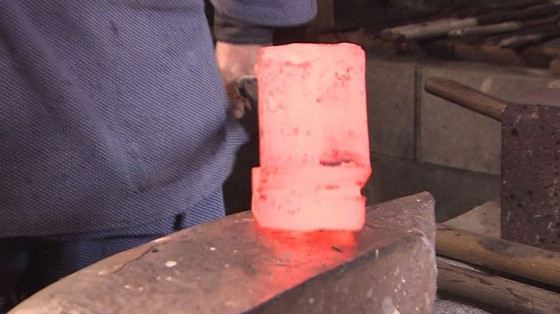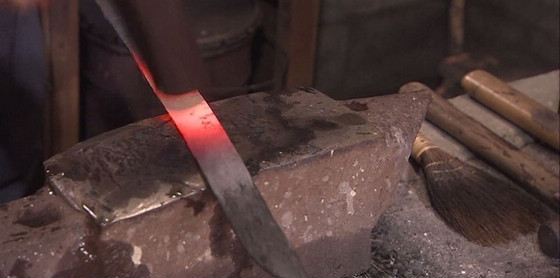Katana has become a symbol for Japan. Also known as Samurai sword, it roots in a really long time ago and leaves a deep impression on lots of people. Nowadays, since cosplay becomes a popular entertainment activity, most people do love to put those shape swords into good use. But believe it or not, it won’t be easy to make a katana for cosplay, especially after you follow us to pay a visit to the Japan Katana Forging Research Institution below.

In Japan, it’s called as かたな or つるぎ, which is one of the three most popular swords across the world. According to shape and size, it can be divided into Tachi, Uchikatana, Wakizashi, Tantou, etc.

Katana is not only a kind of weapon, but also a beautiful artwork or artistic product. How can such an item that is subsided by history be made? Now, let’s explore the secret of the Japan Katana Forging Research Institution.

The signboard is a little small and the facade of Japan Katana Forging Research Institution is a little tattered. This is really disharmonious with the worldwide influence of katana, XD.

Sword is originally a kind of weapon to kill people. It’s a lethal weapon for human beings. But katana is beyond of lethal weapon. It’s an artwork with sense of beauty. Common katana has a proportion of 1: 4 on hilt and blade. It’s held on hilt by both hands and powerful while hacking. Its bend degree is controlled at the place of 16.7mm below the blade top. The biggest power lies in there, rather fitting the mechanics.

In Japan, katana makers are called as bladesmith, Seiken no Burakkusumisu or sword worker. While making a katana, a rather high-end technique is gathered. As a whole, after making the blade, quenching and polishing, bladesmith needs to make white wooden handle to keep the blade for sale. But the hilt, scabbard and Tan belong to another manufacturing line. They will be decorated by professional metal workers. In the Japanese history, sword workers have different factions. Some of them are even exclusive workers from shogunate.

Go to factories of making swords, you will find all katana are fully handmade. They are processed by experienced old workers personally. Lots of time is spent on making a katana. Workers have never stopped thinking about improving the making methods. Raw materials are high-class Tamahagane in Japan, which will only produce deluxe artworks.

Tamahagane is forged by a traditional indigenous method in Japan. It refers to a kind of steelmaking way under low temperature. The furnace temperature is never beyond 100℃. This method seems primitive. But compared with modern high temperature steelmaking ways, it more easily produces pure and high-quality steel.

But steel forged by high temperature is rather soft and easier to be forged to the desirable shape. Steel forged by low temperature is a little hard and difficult to be forged. So to speak, making katana is a manpower intensive work. Blood and sweat get quality in return.

Pill forging is a crucial process during forging a katana. It means that bladesmith heats the steel to be transparently red and forges it by beating. When the heat is open while being thumped, fold it and beat it over and over. After times’ thumping, the steel can be extended to the fullest.
In most cases, the steel needs to be folded 7 or 8 times. Sometimes it will be folded by 20 to 30 times. In each time’s thumping, more than 100 times are needed. By this step, impurity in steel like sulphur and carbon can be cleared away to enhance the elasticity and tenacity of steel.

Quenching is definitely so-called thermal treatment. In Japan, it’s called as Mizuheshi. From the view of modern material theory, this step enables bladesmith to control the carbon content in steel.

A circular model is used on both the sword point and the whole blade of katana. The phenomenon of blade being arc is due to the collocation of steel and quenching.

The packaging method of katana is rather tasteful. Different decorations are used onto diverse categories in different eras. Katana, widely known all over the world, is not a kind of weapon, but an artwork. It has a rather high artistic value for collectors.
To make a katana is different with to make a costume or a pair of shoes for cosplay. It’s much more difficult and technological. Thus, those bladesmithes deserve saluting.